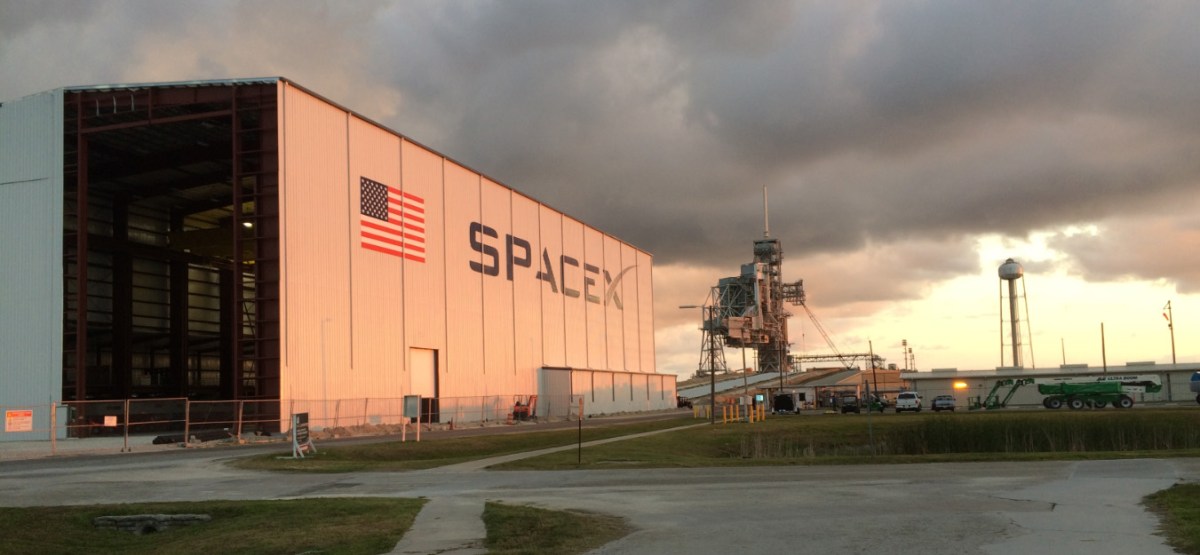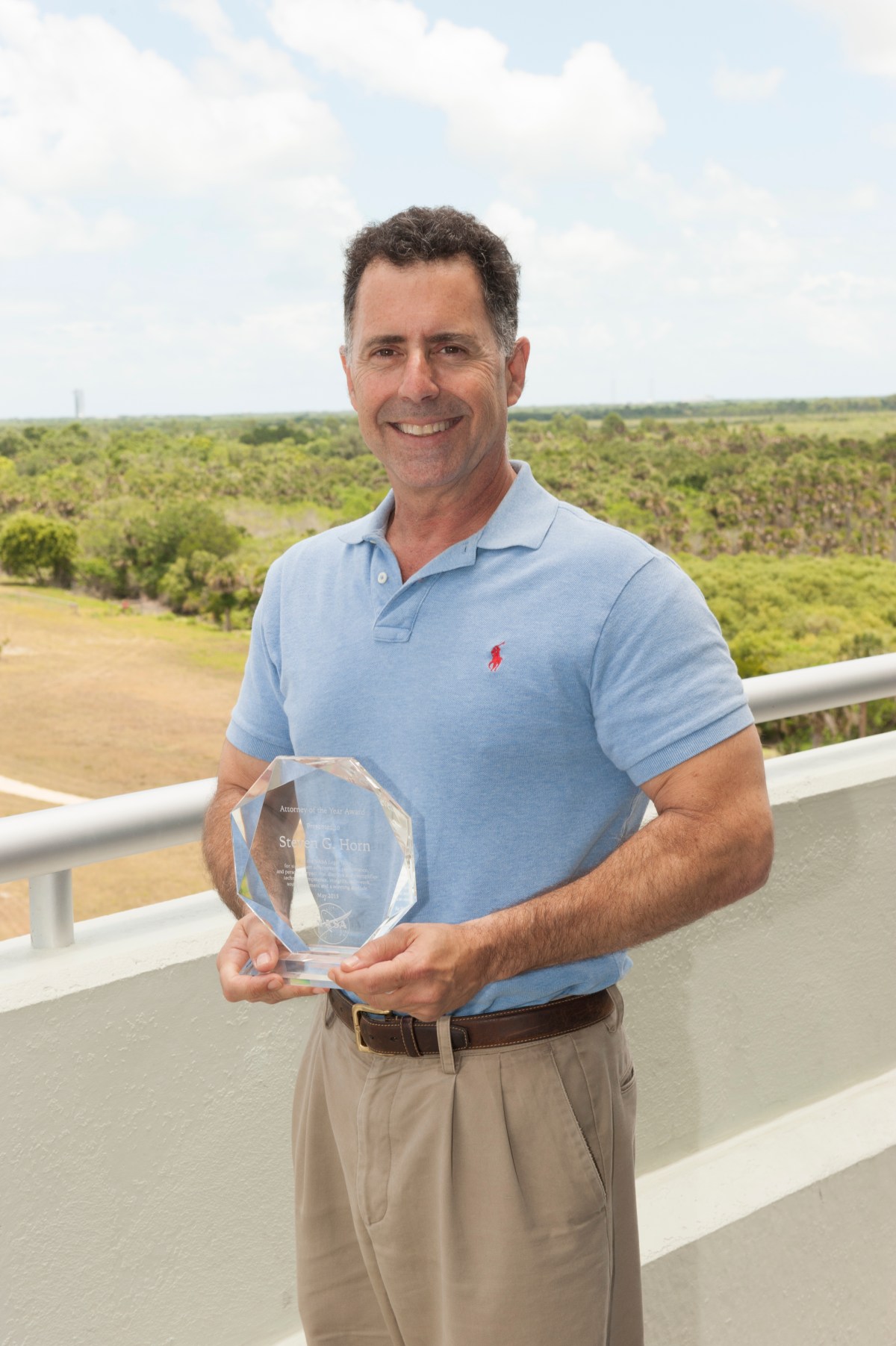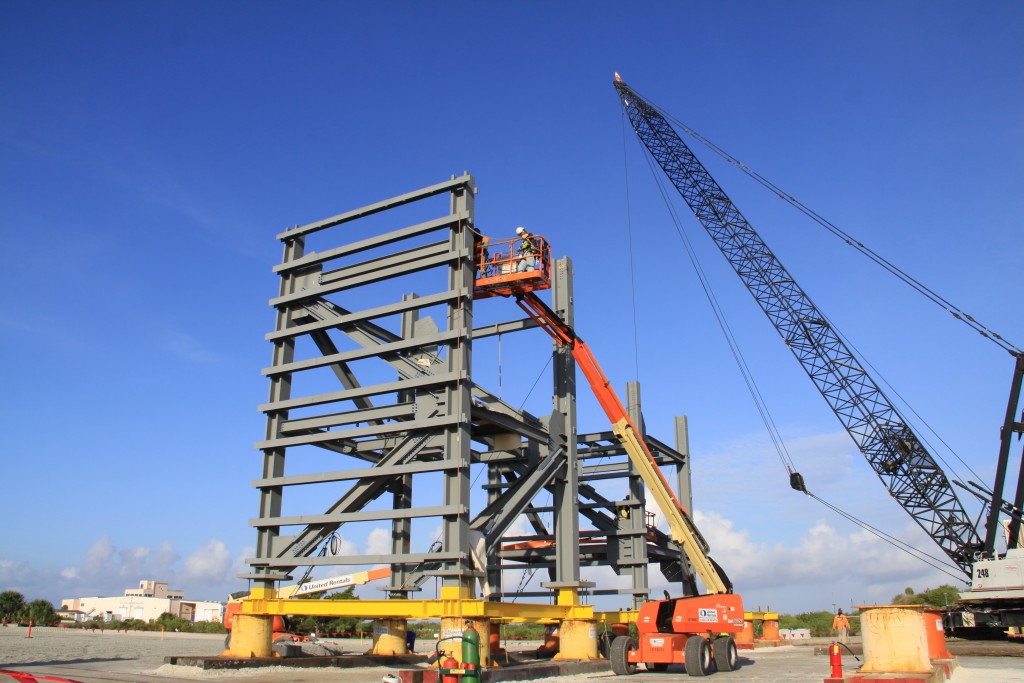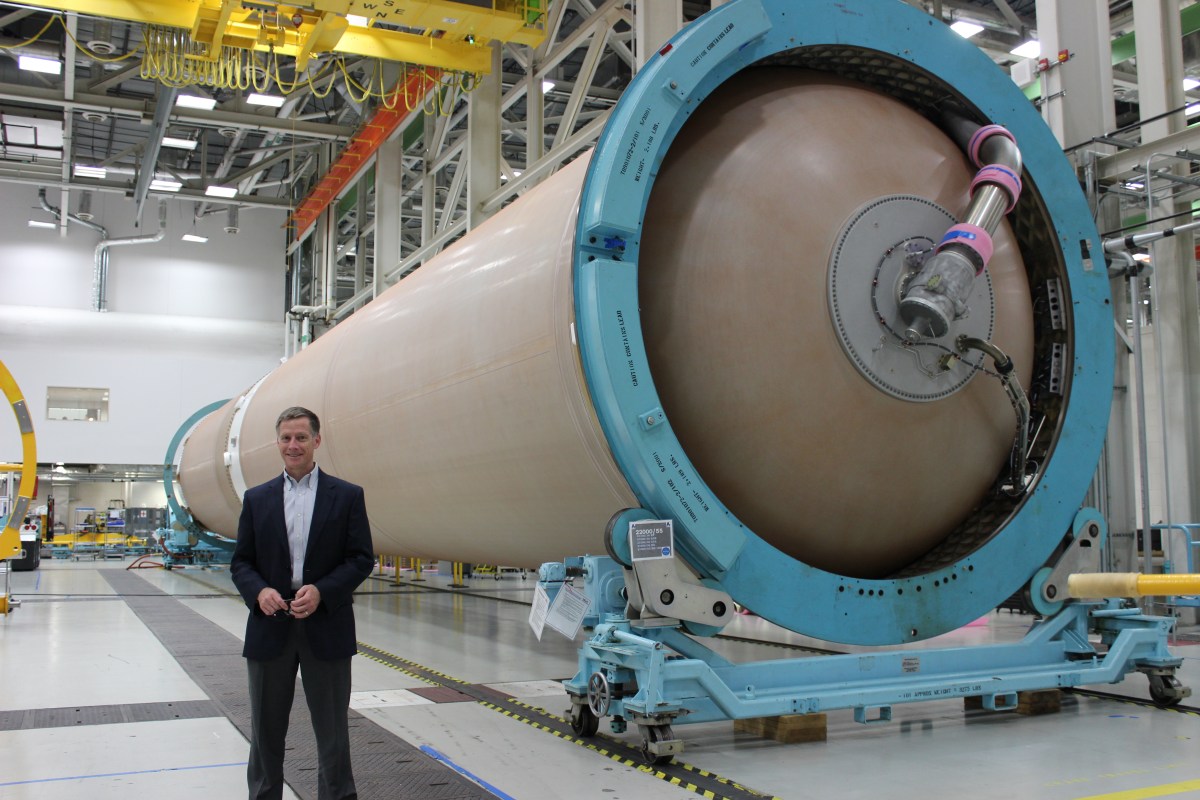 SpaceX released a new photo showing the progress the company is making on an assembly hangar at Kennedy’s historic Launch Complex 39A. The company says the building will be big enough to house five Falcon rockets at once. The launch pad is being outfitted for missions by the Falcon Heavy and for Commercial Crew flights using the Falcon 9 rocket launching Crew Dragons to the International Space Station with NASA astronauts onboard.
SpaceX released a new photo showing the progress the company is making on an assembly hangar at Kennedy’s historic Launch Complex 39A. The company says the building will be big enough to house five Falcon rockets at once. The launch pad is being outfitted for missions by the Falcon Heavy and for Commercial Crew flights using the Falcon 9 rocket launching Crew Dragons to the International Space Station with NASA astronauts onboard.
Category: CCtCap
No Recess for Attorney of the Year
By Steven Siceloff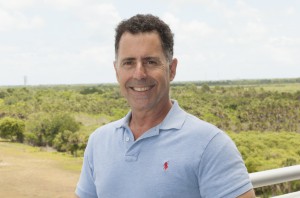
NASA’s Kennedy Space Center, Fla.
Three months of seven-day work weeks including a month of 17-hour days punctuated the end of 2014 for Steven Horn. As assistant chief counsel at Kennedy, Horn worked to defend
the decisions by NASA’s Commercial Crew Program to award contracts to Boeing and SpaceX under the Commercial Crew Transportation Capability phase. The effort was intense and draining, but equal parts rewarding for the lawyer who has since been named the agency’s Attorney of the Year.
“This procurement was very complex, given the parallel space act agreements and phased acquisition and all,” Horn said. “We have to bring the level of expertise that the engineers have down to a more readable level when making findings when they are going to be reviewed by someone who doesn’t necessarily have that technical background. That can be difficult at times.”
Horn’s legal career began following his graduation from the University of Florida’s Levin College of Law. After a couple years in private practice, Horn joined the Air Force where he worked in the Judge Advocate General department before going to Tinker Air Force Base in Oklahoma, where contracts and labor-related issues became his specialty. Having traveled the world in the Air Force, Horn opted to settle down in Florida, and came to work for NASA at Kennedy Space Center in 1998.
“Every day here is a challenge, whether it’s contracts, space act agreements or how we’re commercializing property that NASA has no present use for,” Horn said. “The most rewarding thing for me, bar none, is the people I get to work with. There are some amazing engineers out here, I’m not just saying that. They blow me away every day. I like working with people smarter than me and there are a heck of a lot of people out here smarter than me and it motivates me to bring my game up. That’s what I get a kick out of. It’s that interaction with people and helping create solutions.”
Horn is now the primary legal voice for Commercial Crew, beginning that role two years ago when he became a part of the source board to acquire services for the first American-made, human-rated spacecraft since the space shuttle. Then he helped judge how proposals by aerospace companies stacked up against NASA’s requirements for Commercial Crew. Ultimately, the source board made the evaluations before NASA’s hierarchy made the final selection of Boeing and SpaceX.
“The Source Evaluation Board chairwoman, Maria Collura, in my almost 30 years of work, is easily the best that I’ve ever come across,” Horn said. “She was the glue that held the entire team together.”
A couple weeks later, a protest lodged against the decision sent the board and Horn into justification mode. By the time it was complete, more than 160,000 pages had been gathered and reviewed. Ultimately, the Government Accountability Office agreed with NASA’s rationale and approved the contract awards.
“I think the day the announcement was made to select two companies, it showed that all the work we had done for the past year and half as a team was correct,” Horn said. “The day that we got the successful decision was a good day — a very good day for myself and for NASA.”
Commercial Crew Rotation Mission in Motion
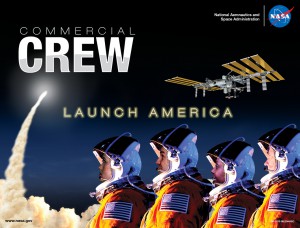 NASA took another step toward returning America’s ability to launch crew missions to the International Space Station from the United States in 2017. Commercial Crew ordered its first crew rotation mission from The Boeing Company. SpaceX is expected to receive its first order later this year. Determination of which company will fly its mission to the station first will be made at a later time.
NASA took another step toward returning America’s ability to launch crew missions to the International Space Station from the United States in 2017. Commercial Crew ordered its first crew rotation mission from The Boeing Company. SpaceX is expected to receive its first order later this year. Determination of which company will fly its mission to the station first will be made at a later time.
“Final development and certification are top priority for NASA and our commercial providers, but having an eye on the future is equally important to the Commercial Crew and station programs,” said Kathy Lueders, manager of Commercial Crew. “Our strategy will result in safe, reliable and cost-effective crew missions.”
Missions flown to the station on Boeing’s CST-100 and SpaceX’s Crew Dragon spacecraft will restore America’s human spaceflight capabilities and increase the amount of scientific research that can be conducted aboard the orbiting laboratory. A standard mission to the station will carry four NASA or NASA-sponsored crew members and about 220 pounds of pressurized cargo. The spacecraft will remain at the station for up to 210 days and serve as an emergency lifeboat during that time.
“Commercial Crew launches are critical to the International Space Station Program because it ensures multiple ways of getting crews to orbit,” said Julie Robinson, International Space Station chief scientist. “It also will give us crew return capability so we can increase the crew to seven, letting us complete a backlog of hands-on critical research that has been building up due to heavy demand for the National Laboratory.”
Watch Relocation of Station Module for Commercial Crew Prep
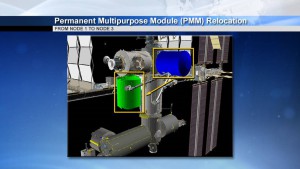 The International Space Station Program will take the next step in expanding a robust commercial market in low-Earth orbit when work continues Wednesday, May 27, to prepare the orbiting laboratory for the future arrival of U.S. commercial crew and cargo vehicles. NASA Television will provide live coverage of the activity beginning at 8 a.m. EDT.
The International Space Station Program will take the next step in expanding a robust commercial market in low-Earth orbit when work continues Wednesday, May 27, to prepare the orbiting laboratory for the future arrival of U.S. commercial crew and cargo vehicles. NASA Television will provide live coverage of the activity beginning at 8 a.m. EDT.
NASA is in the process of reconfiguring the station to create primary and back up docking ports for U.S. commercial crew spacecraft currently in development by Boeing and SpaceX to once again transport astronauts from U.S. soil to the space station and back beginning in 2017. The primary and backup docking ports also will be reconfigured for U.S. commercial spacecraft delivering research, supplies and cargo for the crew.
On Wednesday, robotics flight controllers at the Mission Control Center at NASA’s Johnson Space Center in Houston will detach the large Permanent Multipurpose Module, used as a supply depot on the orbital laboratory, from the Earth-facing port of the Unity module and robotically relocate it to the forward port of the Tranquility module. This move will clear the Unity port for its conversion into the spare berthing location for U.S. cargo spacecraft; the Earth-facing port on Harmony is the primary docking location. Harmony’s space-facing port currently is the spare berthing location for cargo vehicles, so this move frees that location to be used in conjunction with Harmony’s forward port as the arrival locations for commercial crew spacecraft.
The transformation of Harmony’s space-facing and forward ports for crew arrivals will continue later this year, when a pair of International Docking Adapters will be delivered on the seventh and ninth NASA-contracted SpaceX cargo resupply missions. The IDAs will be attached to Pressurized Mating Adapters 2 and 3, which enable the spacecraft to equalize internal pressure with the ISS.
Crew Access Tower Coming Together for CST-100
Workers are deep into construction of the first two tiers of the new crew access tower for Space Launch Complex 41 at Cape Canaveral Air Force Station in Florida. Boeing and United Launch Alliance are building the tower so astronauts and ground support teams can access the CST-100 spacecraft for missions to the International Space Station. Offsite construction of the tiers was essential to be able to sustain the launch schedule of the Atlas V rocket – which will carry the CST-100 – and still provide a human-rated service structure NASA needs for its Commercial Crew flights.
The first two structures will be outfitted with nearly everything they will need at the launch pad except wiring and the elevator shafts before they are stacked and trucked over to the launch pad. It will take seven tiers to complete the 200-foot-tall structure. While the tiers are assembled a few miles away, workers at SLC-41 are preparing the foundation of the structure. Pile drivers, cement trucks and other heavy equipment are establishing a firm support base for the tower.
Commercial Crew In Your City: Chatsworth’s Aitech to Build CST-100 Crew Computer, Displays
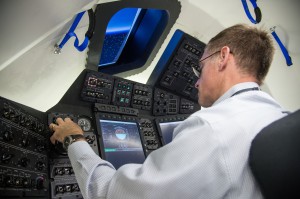 The CST-100 spacecraft Boeing is developing to take astronauts to the International Space Station will feature a crew interface system computer and displays built by Aitech Defense Systems of Chatsworth, California. Aitech’s work will allow pilots of the CST to assume direct control over the spacecraft in orbit to adjust its attitude, height and direction with precision.
The CST-100 spacecraft Boeing is developing to take astronauts to the International Space Station will feature a crew interface system computer and displays built by Aitech Defense Systems of Chatsworth, California. Aitech’s work will allow pilots of the CST to assume direct control over the spacecraft in orbit to adjust its attitude, height and direction with precision.
Three CST-100s are to be built at Boeing’s Kennedy Space Center location in preparation for a pad abort test, unpiloted flight test and piloted flight test to the station in 2017. The spacecraft will include numerous systems and subsystems built by subcontractors all over America.
NASA’s Commercial Crew Program is working with Boeing and SpaceX under separate Commercial Crew Transportation Capability contracts to return crew launch capabilities to the United States. The new spacecraft also will increase research capacity on the station by adding a crew member to the orbiting laboratory and allowing scientific time available to double to 80 hours a week.
SpaceX Commercial Crew Pad Abort Test Coverage and Credentialing Details
 SpaceX currently is targeting no earlier than Tuesday, May 5, for a pad abort test of its Crew Dragon development spacecraft from Space Launch Complex 40 at Cape Canaveral Air Force Station. The ability to abort from a launch or pad emergency and safely carry crew members out of harm’s way is a critical element for NASA’s next generation of crew spacecraft.
SpaceX currently is targeting no earlier than Tuesday, May 5, for a pad abort test of its Crew Dragon development spacecraft from Space Launch Complex 40 at Cape Canaveral Air Force Station. The ability to abort from a launch or pad emergency and safely carry crew members out of harm’s way is a critical element for NASA’s next generation of crew spacecraft.
The company will have a four-hour window to conduct the test, beginning at about 9:30 a.m. EDT. SpaceX has an additional test opportunity on Wednesday, May 6. NASA TV will provide live coverage of the test. NASA TV also will air a media briefing previewing the test with SpaceX and NASA representatives at 10 a.m. Friday, May 1.
SpaceX will perform the test under its Commercial Crew Integrated Capability (CCiCap) agreement with NASA, but can use the data gathered during the development flight as it continues on the path to certification. Under a separate Commercial Crew Transportation Capability (CCtCap) contract, NASA’s Commercial Crew Program will certify SpaceX’s Crew Dragon, Falcon 9 rocket, ground and mission operations systems to fly crews to and from the International Space Station.
More about media credentialing and coverage details available here.
Boeing Tests its Commercial Crew Spacecraft at Langley
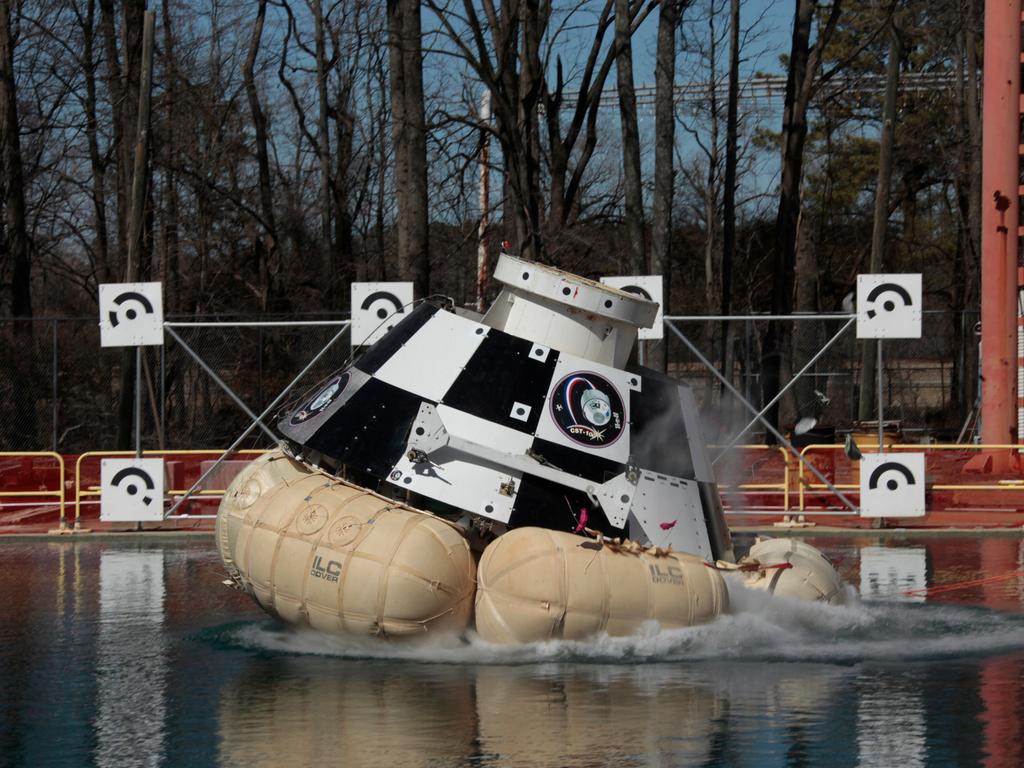
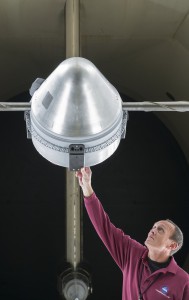 Boeing took its CST-100 spacecraft mock-up and a scale model to NASA’s Langley Research Center in Hampton, Va., recently for a series of tests designed to evaluate different aspects of the design. The CST-100 is the spacecraft Boeing is developing in partnership with NASA’s Commercial Crew Program to carry astronauts to the International Space Station using American spacecraft and rockets launching from the United States. The full-scale version of thespacecraft was dropped into water at Langley to judge how the spacecraft would behave in case it had to make a quick return to Earth and could not land on the ground. The CST-100 is designed to descend from orbit under parachutes with inflatable bags cushioning the landing for crew members inside. A smaller model was used inside one of the Langley wind tunnels to determine how the air flows around the outside of the spacecraft when it inside Earth’s atmosphere and different phases of flight. Read more about this critical evaluation cycle for the CST-100 at http://go.nasa.gov/1Df0i9A
Boeing took its CST-100 spacecraft mock-up and a scale model to NASA’s Langley Research Center in Hampton, Va., recently for a series of tests designed to evaluate different aspects of the design. The CST-100 is the spacecraft Boeing is developing in partnership with NASA’s Commercial Crew Program to carry astronauts to the International Space Station using American spacecraft and rockets launching from the United States. The full-scale version of thespacecraft was dropped into water at Langley to judge how the spacecraft would behave in case it had to make a quick return to Earth and could not land on the ground. The CST-100 is designed to descend from orbit under parachutes with inflatable bags cushioning the landing for crew members inside. A smaller model was used inside one of the Langley wind tunnels to determine how the air flows around the outside of the spacecraft when it inside Earth’s atmosphere and different phases of flight. Read more about this critical evaluation cycle for the CST-100 at http://go.nasa.gov/1Df0i9A
SpaceX Engine Test Demonstrates Pad Abort Test Profile
SpaceX ignited two of its SuperDraco engines together at the company’s Rocket Development Facility in McGregor, Texas, during a recent test of the reusable system. This specific test was a demonstration of a pad abort test profile, with two SuperDraco engines igniting simultaneously and throttling as they will during an upcoming flight test at Cape Canaveral Air Force Station in Florida.
The SuperDraco engine is vital to the safety of the company’s Crew Dragon spacecraft under development to carry crew to the International Space Station. Four SuperDraco pods, with two engines in each for a total of eight engines, are to be arranged on the sides of a Crew Dragon capsule. During launch and ascent into space, the eight rocket engines would be called on to push the spacecraft and crew out of danger in case of an abort.
The pad abort test will be performed under the company’s Commercial Crew Integrated Capability (CCiCap) agreement with NASA. SpaceX can use the data gathered during the development flight as it continues on the path to certification. Under a separate Commercial Crew Transportation Capability (CCtCap) contract, SpaceX is working with NASA’s Commercial Crew Program to certify the Crew Dragon, Falcon 9 rocket, ground and mission operations systems to fly crews to and from the space station.
Rockets for Commercial Crew Spacecraft Launches Coming Together
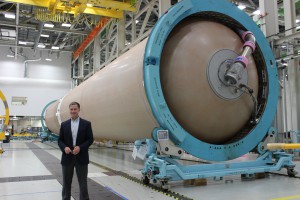 Their tail numbers are AV-073 and AV-080 and they are two of the Atlas V rockets expected to make history when they launch Boeing’s CST-100 on a pair of flight tests to set the stage for operational flights in the future carrying astronauts to the International Space Station. The first flight will not carry anyone but will perform orbital checkouts to prove the CST-100 systems. The second flight is to have people aboard and run a mission profile similar to the ones NASA will ask for when it begins regular Commercial Crew missions to the orbiting laboratory. Read the full story at http://go.nasa.gov/1bk4ifJ
Their tail numbers are AV-073 and AV-080 and they are two of the Atlas V rockets expected to make history when they launch Boeing’s CST-100 on a pair of flight tests to set the stage for operational flights in the future carrying astronauts to the International Space Station. The first flight will not carry anyone but will perform orbital checkouts to prove the CST-100 systems. The second flight is to have people aboard and run a mission profile similar to the ones NASA will ask for when it begins regular Commercial Crew missions to the orbiting laboratory. Read the full story at http://go.nasa.gov/1bk4ifJ

